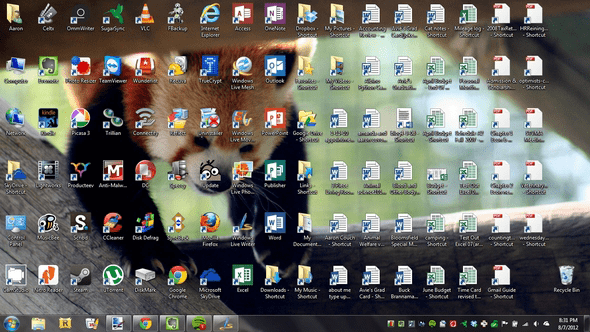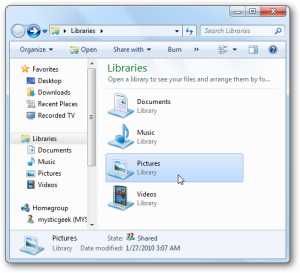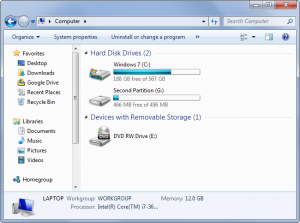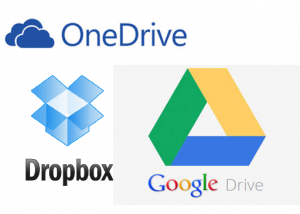Better Ways To Store Your Files Than On The Desktop
John M. Haddad
Did you know that storing files directly on your desktop can harm your productivity? When visiting many of my clients, I am so surprised by the number of people who download files straight to the desktop. If you can identify with that, then you need to read further. Desktop storage is simple, sure, but it comes with hidden drawbacks you may not know about. Does your desktop look like this?

Take a look at the drawbacks of storing your files this ways, then kick the “bad habit” with these alternative file storage methods. They may not be as convenient but you’ll learn to love them in the long run.
Drawbacks of using Desktop Storage
As I’ve mentioned, the urge to save files to the desktop is understandable. You can get immediate access to files with just one double-click, instead of traversing layers of folders. However, you will encounter many issues, such as:
- No file protection. Your PC has the capability to do a System Restore. If you ever have to do a restore, certain directories, such as My Documents, My Pictures, My Videos will be ignored by the restore and not wiped out. In other words, the restore assumes that your personal data is located in the designated data directories. Your desktop is not considered a data directory, so you risk having the restore “wipe out” all files on the desktop, thereby losing your data.
- No file backups. Many file backup programs ignore desktop files by default and focus primarily on the data directories. Certainly, you can modify the settings to tell the backup program to backup your desktop also, however, many people just use the backup program right out of the box and forget to modify the settings. In addition, many company-wide backup implementations will only look at the data directory and not give their employees the backups of other directories.
- Can’t find that file. So, you get your new PC with a clean desktop. You begin your desktop collection with a few documents. Over time, the collection grows to include images, music, programs, zip files, and more documents. After a while, finding the right document takes more time than actually opening it.
What are some solutions?
1. Use the Windows libraries
 Every installation of Windows comes with a directory called My Documents. In Windows 7, it was renamed to Documents and came with a couple of buddies: Music, Pictures, and Videos. They’re called libraries and you may have seen or used them, but again, choose the simpler store on the desktop.
Every installation of Windows comes with a directory called My Documents. In Windows 7, it was renamed to Documents and came with a couple of buddies: Music, Pictures, and Videos. They’re called libraries and you may have seen or used them, but again, choose the simpler store on the desktop.
Actually, these four libraries are special. They aren’t just directories; they’re collections of multiple directories. In each library, you can specify different directories to be included and that library will show the content from all included directories. It sounds more complicated than it is.
It’s just as convenient as storing everything on the desktop, yet infinitely more flexible and organized. I put a shortcut to my documents folders on my desktop so instantly, I have access to all my documents, music, pictures or videos.
Here’s a tip. Many times I like to have working folders or documents on my desktop for quick access. So if I’m working on a project called the Jones Project, I first create a folder in my Documents library called Jones Project. Then, I right-click that folder and drag it to my desktop. When I release the mouse, I’m presented with several options. One is to create a shortcut to that folder. I select that option and a shortcut to that folder is now on my desktop. You will know it’s a shortcut because it will have a small curved arrow on the file or folder. The folder still exists in my library, but I can access it with the shortcut. When I’m done with that project, I just delete the shortcut.
2. If possible, keep your data in a separate drive partition
 Many new computers these days have multiple drive partitions when they ship to you. One is for the operating system and one is for the data. Usually, the space for the operating system is just enough to handle all the files needed to operate your computer (e.g. Windows operating system). If your computer came this way, you are all set. If not, and both your operating system and data are all in the same partition, it get’s more complicated to change this.
Many new computers these days have multiple drive partitions when they ship to you. One is for the operating system and one is for the data. Usually, the space for the operating system is just enough to handle all the files needed to operate your computer (e.g. Windows operating system). If your computer came this way, you are all set. If not, and both your operating system and data are all in the same partition, it get’s more complicated to change this.
One bit of computer wisdom that you should learn is this: “Never save data on the same partition as your operating system.” So, why is this important advice? Because you want to avoid putting all of your eggs in the same basket.
Let’s say that you happen to contract a mild virus or malware that attacks your operating system. It might wipe all files related to the operating system itself OR it may affect the entire partition that holds the operating system. By having everything in one partition, say in drive C:, if you losethe operating system, you lose all of your saved data as well.
But if you installed Windows to the C: partition and stored all of your files on the D: partition, your files on D: would be safe even if C: were wiped clean. The only way D: would be affected is if the physical hard drive itself was wiped or damaged. Additionally, by having separate partitions is that you can reinstall Windows without losing your saved data.
3. Store files in the Cloud
 I’ve written several posts about the benefits of cloud storage and cloud backup. Cloud storage has been a the big rage over the past few years and for good reason.
I’ve written several posts about the benefits of cloud storage and cloud backup. Cloud storage has been a the big rage over the past few years and for good reason.
While cloud-related solutions like Dropbox, Microsoft OneDrive and Google Drive offer many benefits. Many people are skeptical and concerned over privacy, but there are inherent benefits to consider.
You can set aside one or more directories that automatically sync with whatever service you’re using. Then, these files can be accessed from anywhere and they can be set to private or public.
So why is this better than just storing all your files directly on your desktop?
- Immediate backups. Due to automatic synchronization, you rarely need to worry about lost files. If your computer gets wiped somehow, those files still reside on the cloud and you can always retrieve them again.
- Immediate access. You have access to these files on your laptop, tablet, smartphone … or anywhere you have access in the world to a web browser.
- Revision history. Not every cloud service offers a revision history, but most do and it’s an important feature. Basically, the service will track every change that’s made to the file and allow you to instantly revert to a past version if necessary.
Summary
While many people have a personal preference on how they use their computer, breaking the habit of cluttering your desktop with your files is a tough habit to break.
However, I hope after reading this post that you can see the risk that you may be incurring by doing this and the benefits you can achieve with a more organized approach using Libraries, Drive Partitions and/or Cloud Storage.
View other posts

Share this post
Recent Posts

